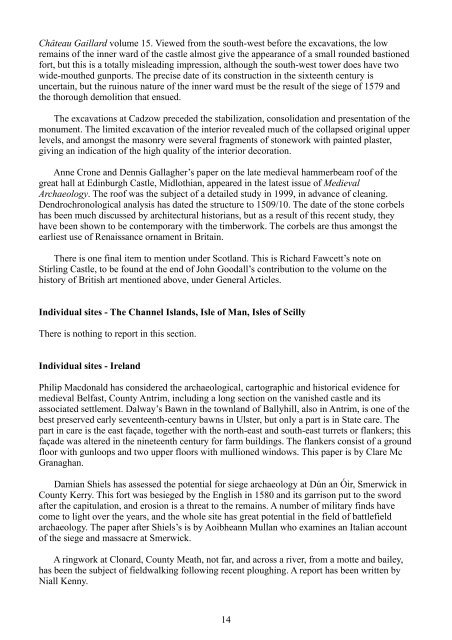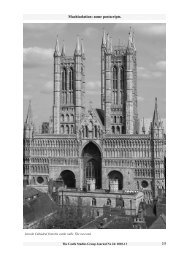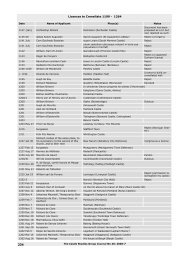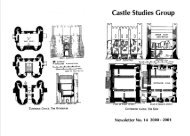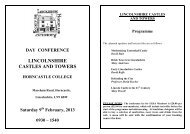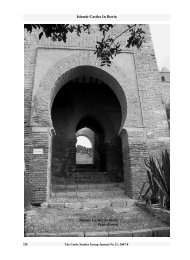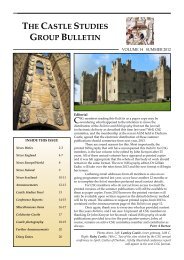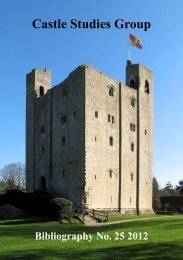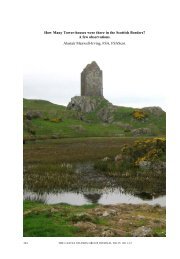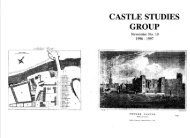Castle Studies Group Bibliography No. 22 2009
Castle Studies Group Bibliography No. 22 2009
Castle Studies Group Bibliography No. 22 2009
You also want an ePaper? Increase the reach of your titles
YUMPU automatically turns print PDFs into web optimized ePapers that Google loves.
Château Gaillard volume 15. Viewed from the south-west before the excavations, the lowremains of the inner ward of the castle almost give the appearance of a small rounded bastionedfort, but this is a totally misleading impression, although the south-west tower does have twowide-mouthed gunports. The precise date of its construction in the sixteenth century isuncertain, but the ruinous nature of the inner ward must be the result of the siege of 1579 andthe thorough demolition that ensued.The excavations at Cadzow preceded the stabilization, consolidation and presentation of themonument. The limited excavation of the interior revealed much of the collapsed original upperlevels, and amongst the masonry were several fragments of stonework with painted plaster,giving an indication of the high quality of the interior decoration.Anne Crone and Dennis Gallagher’s paper on the late medieval hammerbeam roof of thegreat hall at Edinburgh <strong>Castle</strong>, Midlothian, appeared in the latest issue of MedievalArchaeology. The roof was the subject of a detailed study in 1999, in advance of cleaning.Dendrochronological analysis has dated the structure to 1509/10. The date of the stone corbelshas been much discussed by architectural historians, but as a result of this recent study, theyhave been shown to be contemporary with the timberwork. The corbels are thus amongst theearliest use of Renaissance ornament in Britain.There is one final item to mention under Scotland. This is Richard Fawcett’s note onStirling <strong>Castle</strong>, to be found at the end of John Goodall’s contribution to the volume on thehistory of British art mentioned above, under General Articles.Individual sites - The Channel Islands, Isle of Man, Isles of ScillyThere is nothing to report in this section.Individual sites - IrelandPhilip Macdonald has considered the archaeological, cartographic and historical evidence formedieval Belfast, County Antrim, including a long section on the vanished castle and itsassociated settlement. Dalway’s Bawn in the townland of Ballyhill, also in Antrim, is one of thebest preserved early seventeenth-century bawns in Ulster, but only a part is in State care. Thepart in care is the east façade, together with the north-east and south-east turrets or flankers; thisfaçade was altered in the nineteenth century for farm buildings. The flankers consist of a groundfloor with gunloops and two upper floors with mullioned windows. This paper is by Clare McGranaghan.Damian Shiels has assessed the potential for siege archaeology at Dún an Óir, Smerwick inCounty Kerry. This fort was besieged by the English in 1580 and its garrison put to the swordafter the capitulation, and erosion is a threat to the remains. A number of military finds havecome to light over the years, and the whole site has great potential in the field of battlefieldarchaeology. The paper after Shiels’s is by Aoibheann Mullan who examines an Italian accountof the siege and massacre at Smerwick.A ringwork at Clonard, County Meath, not far, and across a river, from a motte and bailey,has been the subject of fieldwalking following recent ploughing. A report has been written byNiall Kenny.14


